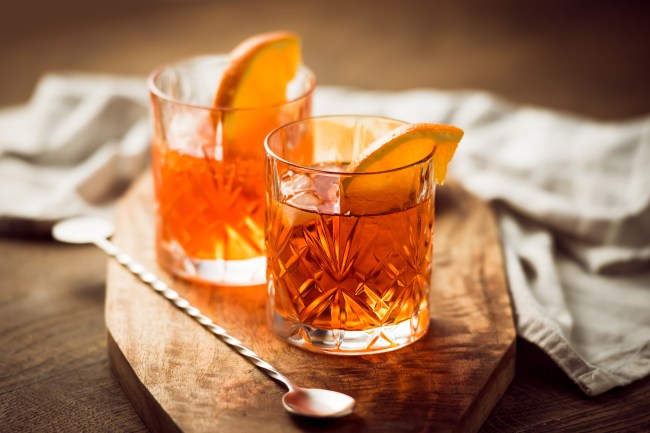
It’s pretty safe to say that craft cocktail culture is spiking worldwide. The upside is that we’re drinking and rediscovering classic drinks and inventing new ones every day. The downside is that going out and getting sloppy on cocktails is expensive, sometimes prohibitively so.
Mixing cocktails is a little science, a little sensory, a little storytelling, and a lot of joy. If you’re willing to spend some time learning and experimenting, you’ll have a skill for life (and a lot of drunk friends).
I’ve bartended off and on for the past 15 years in various countries. Most recently in a high-end cocktail bar in Berlin called Victoria Bar. Here are a few thoughts on how to make a home bar without having to mortgage the house, or dip into the kid’s college fund every time you want to drink more than one $15 Old-Fashioned.
Recipes
Cocktails are deceptively simple: a base, an enhancer and bitters. That’s it. The mixing of said ingredients is what makes each drink special. Some people barely like the shadow of the bottle of Noilly Prat Vermouth looming over their gin for a Dry Martini. Others want a 50/50 mix. Luis Buñuel probably has my favorite Dry Martini recipe. Put your glass in the freezer the day before (a 6 ounce rocks glass will do). Add three large cubes of deeply frozen ice (at least below -20F). Over the ice add 4 dashes of Angostura Bitters and 1 ounce of Noilly Prat Dry Vermouth. Stir very lightly for about 10 seconds, maybe 15. Drain the fluid away, preserving the ice. Pour 4 ounces of English gin (I like Plymouth) over the ice and gently stir once. Serve. No Garnish.
See? That’s pretty easy. It’s also delicious. Down and dirty, as I like to say.
Learn:
Buy some books from Amazon and read them. Start with the classic The Bartender’s Guide: How To Mix Drinks: A Bon Vivant’s Companion. It’s $1.99 for the kindle version and a good place to get a foundational footing. Move onto to books that have recipes, but also teach you the history of booze, like The School of Sophisticated Drinking: An Intoxicating History of Seven Spirits. Learn the recipes. Learn some stories behind the recipes (more on that later). Then practice at home. Most importantly learn what it is you like, and play to that strength. Mixing a Mai Thai is complicated and requires several ingredients you’ll probably only use when you have a Mai Thai (Ogreat, I’m looking at you!), so let the pros do that one for you when you’re out on the town.
Once you have a good base knowledge of what makes a drink a drink, start experimenting. A Whiskey Sour is bourbon, fresh lemon juice, and simple syrup (and often an egg white). The variations therein are massive. Use fresh orange juice and a spoon of Bénédictine and you have a Frisco Sour. Change it up entirely and use a 10-year-old single malt, fresh lime, and gomme. Call it an Edinburgh Sour. Drop the whisk(e)y all together and use rum, vodka, gin, amaretto. Why not? A “sour” is a base, citrus, and sweetener. Have fun! A personal favorite for me is the tequila sour. Add three ounces of smokey, aged tequila to a Boston shaker. Top that with two ounces of fresh squeezed AND strained lime juice and 1 ounce of agave syrup. Add your ice and shake for about 20 seconds. Strain into a chilled six-ounce rocks glass. Serve. Simple, easy, and delicious. Just remember, the point is to have fun with it. And get buzzed.
Tools
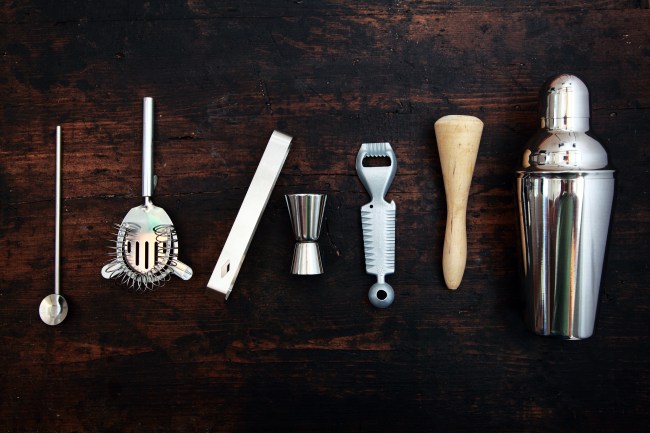
So, you’ve spent maybe 20 bucks buying some books. That’s basically the cost of 2-ish drinks at a bar. You’ve learned some recipes and are inspired. Now you need to think about how you’re actually going to mix these inspiring drinks.
Essentials:
- Boston shaker. A 30 ounce shaker, pint glass, and good strainer will set you back about $30.
- Bar Spoon. The narrow spoon really does make a difference, and it’s about 5 bucks.
- Do you already own a shot glass? Of course you do, you’re reading this. You don’t need to waste money on jiggers. A standard U.S. shot glass is one or two fluid ounces, sometimes they come in 1.5 ounces…for some reason. Anyway, just use what you have, but be sure to know the volume of your shot glass.
- A cocktail mixing jug is awesome. They can also cost close to $100. Honestly, as long as it is glass, you’re going to be fine. Buy a large (30 ounce) jar of something, eat its contents, run the jar through the dishwasher. You now have a mixing jug. Or you can spend $30 to $50 on a nice seamless glass mixing jug on Amazon. Note: if you do get a seamless mixing glass, do not wash it in hot water, it will crack. Just rinse it in cold water between uses, and wash it in cold water when you’re done for the night. Remember, you’re filling it with alcohol, which kills bad bacteria.
- Hand citrus juicers are a must. Don’t skimp here. You will need a heavy device that can withstand a lot of use and pressure. Generally, you can find kitchen grade hand juicers for around $20. I’d also invest in a small, steel manual juicer you can put over bowls or jugs for the larger oranges and grapefruits. That’ll run you another $10.
- Strainers. You really need to strain your citrus between juicing and bottling/storage. Don’t skip this step. Spend $10 on a set of small and medium kitchen strainers. This will also be essential for making infusions (more on that later).
- Muddler. A decent heavy wooden muddler should cost around $3. It’s cheap enough that it really doesn’t make sense not to have it on hand.
- A funnel is pretty useful. If you’re prepping some citrus juice, or refilling bottles from infusions, it just makes life easier. A stainless steel set will set you back around $7.
- Dashers are not 100% essential, but make for a step up in your cocktail game. Decanting bitters into a dasher will allow better control over measurements and finishing a drink. Before you know it you’ll be drawing landscapes on a continental sour with port. You only really need one, and they’re about $20.
And that’s all you really need for a basic set up to start mixing drinks. $105 if you go the bargain end. That’s close to one night out drinking and eating. All of us can skip a night out and save enough money to start our home bar.
Blenders are up to you… I would wait until you mastered mixing before you start whipping up fancy Caribbean drinks.
Glassware
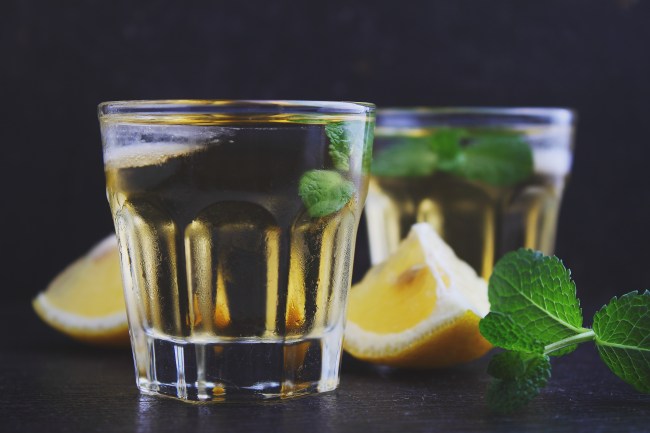
Once again, down and dirty — that’s my cocktail ethos at home. Do not break the bank buying coupes, cocktail glasses, flutes, high balls, and old-fashioned glasses. Go to IKEA. Buy a set of six five-ounce Pokals for $2.99 for your sours, dry martinis, manhattans, etc. Buy a set of six nine-ounce Pokals for $4.99 for your old-fashioneds, Negronis, etc. And buy a set of six 12-ounce Pokals for $5.34 for Moscow Mules, Tom Collins, and high balls. You’ve just spent $13.32 before tax for all the sizes of glasses you’ll need. Sure, they aren’t fancy. Also, there’s no 20-ounce option for a Hurricane, but, let’s face it, no one needs 20 ounces of hurricane outside of Nola. It’s what you put in the glass that matters (and whether you’ve properly chilled them).
I like to shop at flea markets. I always look for new, classic glassware when I do. I pick up some coupes here, some Nick & Noras there. Collect nice glassware over time. Build a set that is you, that has a story behind it. In the meantime, get some cheap glass that won’t break your heart if it breaks while you’re learning. No one will ever turn away a great cocktail because it is not in the exactly correct cocktail glass.
In the meantime, we’re up to about $120 in supplies to run a bar out of your home. Maybe consider cooking a meal at home instead of ordering a pizza. That’ll cover the extra cost of getting some cheap, dedicated glass for your drinks.
Alcohol
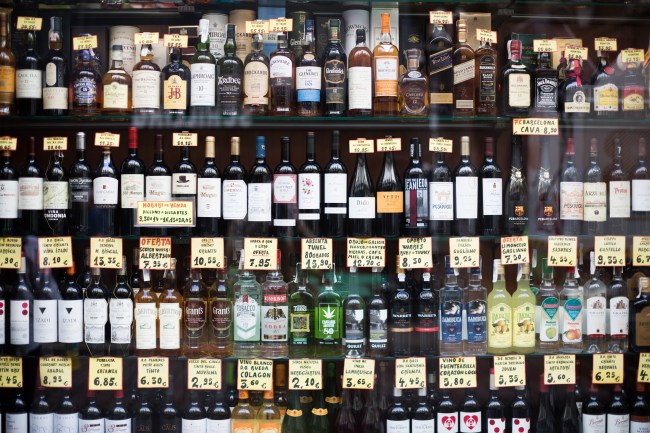
Okay, this is where it gets expensive. The best advice is to collect, don’t splurge.
Essential Bases:
I generally aim for the $20/bottle bracket. Four Roses Bourbon, Bombay Dry Gin, Stolichnaya Vodka, Dewar’s Scotch, Bacardi 8 Anos Rum, Torres 10 Brandy, Cuervo Especial Tequila. You’re aiming to mix drinks here. Not sip next to the fire. All of these bottles are perfectly acceptable for mixing. You’re looking at about $140 investment for the widest range of bases. Collect better bottles over time. I prefer rye to bourbon, but I’m not buying a $50 bottle of rye every two weeks. That adds up way too fast. Watch sales (especially after major holidays) and be patient. You don’t need everything at once. Build your bottle collection as you build you skills and knowledge.
Essential Enhancers:
Martini and Cizano vermouths are okay. They’ll set you back around $6 a bottle. However, I would spend a little more here. You’re enhancing the flavor of your base alcohol. So really enhance it. I’m a big fan of Dolin. Their dry and sweet vermouth are $15 a bottle. That’s $30 for basically all you need for your home bar. You can buy a nice bottle of Antica Formula Vermouth for $40 later. I would also get a $30 bottle of Cointreau. Triple Sec will do the trick though and will set you back closer to $10.
Essential Bitters:
You need three: Angostura, Campari and an absinthe (which I know is a spirit, but you’ll rarely drink it as one). They should set you back $15, $30 and $30 respectively. $75 and you have basically all you need to make a plethora of cocktails. Your Angostura is the industry standard bitters for making an old-fashioned, dry martini, and beyond. Later, you may want to consider adding a bottle of Peychaud’s and Orange bitters to your shelf, but it’s not hugely necessary from the outset. Campari is an essential. Negronis, Americanos, and Boulevardiers are crowd pleasers. I would forgo the Aperol for spritzes and just use Campari, they taste better anyway. Lastly, you need absinthe to coat glasses (Sazerac, Rattlesnake, Corpse Reviver #2). Avoid the Czech absinthes as they are full of artificial color and flavor and do not louche. French Absinthe tends to be from the original recipe and is easily available at higher end liquor stores. And it will louche appropriately.
Essential Sweeteners:
I generally always make my own syrups. This is where your mixology game can get really fun and inventive. I like to use seasonal fruits and vegetables to make a simple syrup and go from there. I generally use a 1 to 1 recipe of raw cane sugar and water. I bottle it and it’ll keep in the fridge for a solid month. You can easily spend plenty of cash on a bottle of Gomme, Simple, Agave, Blackberry, and so many more. You’re probably not going to make Gomme, Grenadine, and Agave syrup. Buy those if you need them. Otherwise, make it yourself. It takes less than 5 minutes and costs pennies.
Extras:
I always keep one bottle of sparkling white wine, one bottle of port, and one bottle of fino sherry on hand. Again, don’t break the bank here. Buy local wine if you can. You don’t need a Vintage Dom P to make a French 75 — it just has to be nice and dry. I’d also recommend buying them in half bottles. That way if you’re making cocktails that require sparkling wine for only two or three drinks, you’re not left with half an open bottle. $10 will get you a decent Spanish Sherry. Osbourne is perfectly acceptable. Same goes for the Port. Any bottle around $10-$15 is going to do the trick. You’ll mostly be either floating it over whiskey sours, or dashing it over continental sours. All told, you’re looking at $30 to $40.
In total you’re looking at about $300 in alcohol and $120 in supplies. So $420 (natch) for a FULL bar. You do not have to start out with a full bar. Buy a bottle of bourbon, gin, vermouth and bitters and start practicing Manhattans, old-fashioneds, and martinis. Then again, you could forgo the next disappointing iPhone upgrade, and spend all that money on this instead.
Something nice for you:
Every now and then, splurge if you can and get something to sip or shoot. Save up $100 and find something you love. $100 spent on a home bottle will be $400 saved at a bar.
Fresh Ingredients
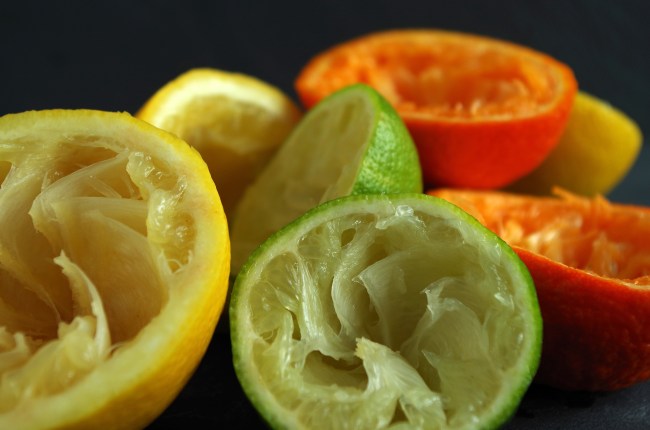
I don’t want to include this in the price to keep your bar going because it varies too widely.
Ice is crucial. If you have a deep freeze, make ice in advance. Put the cubes into a zip lock bags, and store them in a deep freeze that is below -20F. Otherwise, regular ice from your freezer is going to melt way to quickly and over-dilute your drink. This isn’t always an option as we all don’t own deep freezers. Spend a few bucks at the super market for their ice. It’s almost always in a deep freezer. You’ll need medium-sized cubes for mixing and shaking. If you want to invest in a manual ice-crusher, that’s cool. But, you’ll have to deep freeze you’r crushed ice, and then crush it again before use to get an ice that holds up. Or just buy crushed ice from a deep freeze.
Here are some items I always have on hand:
Fresh, organic eggs, lemons, oranges, and limes (sometimes grapefruit). Eggs are a staple. With the three citruses, you can make juice, wedges, and twists. Generally I shave twists off and keep the fruits in the crisper until all the zest is utilized, then I juice the fruit. Maximum potential of the fruit and the least waste is generated that way.
Invest $10 is a nutmeg mill. Your Brandy Alexanders, Milk Punches, Fish House Punches, and Eggnogs are naked without it.
Get some cherries. Two varieties will do the trick: Amarena and Maraschino.
Keep some nice, organic raw sugar on hand.
Buy some fresh ginger. Peel and grate a large thumb of said ginger. Add it to a .7l bottle of gin or vodka or rum, or all three. Let that steep for 24 hours. Strain ALL the ginger bits from the alcohol. Store ginger infused vodka, gin or rum in cool dry place for up to a week, or in the freezer for up to a month. You now have an infused spirit that will amp up your Moscow Mule, London Buck, Gimlet, and Dark & Stormy game. Do not, ever, buy flavored alcohol. Do it yourself. It’s fun to experiment.
Tonics, ginger beers and ales, soda water are all essential, but up to you. Stay away from anything with too much added sugar.
Presentation
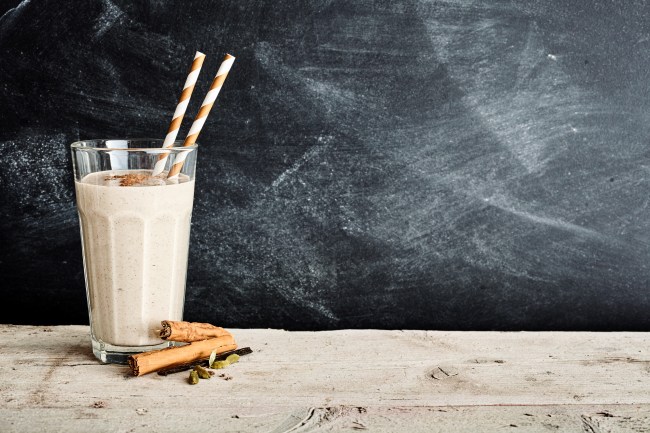
You’ve learned and practiced your recipes. You’ve collected your tools, glasses and booze. Now it is time to mix some drinks.
I actually have a blackboard in my entry way. When we host a party, I’ll write in chalk all the drinks my bar can currently make. It’s a good place to start and allows your guests to know what’s going. It also allows my wife to order a drink when she gets home from work. Always know exactly what’s on your board. If you don’t know the drink, don’t put it up.
Lastly, spend a few bucks on some nice bamboo cocktail sticks and decent wide straws. You don’t need to buy every length. Just buy long ones and cut them in half for rocks glass drinks.
Your friends will probably like to watch the drinks get made. Have a story or two ready. How did you infuse the vodka? What happened to Hemingway’s dog (Negroni was his name) when Papa was out fishing with Castro? Hint: it’s a sad story. Where does the name Old Tom come from? If you have some new glasses you’ve found, premiere them and tell people how your found them.
An essential part of having a home bar is conversation. Being a raconteur is a skill you learn, just like mixing the perfect old-fashioned. Look at your expenses. Where can you save $500 over the next spell to invest in mixing some amazing drinks at home? Save that money and get started.
Zachary Johnston is a director, writer, traveler, and part-time chef and mixologist. You can see for yourself on Instagram @ztp_johnston, or on Twitter@ZTPJohnston.






